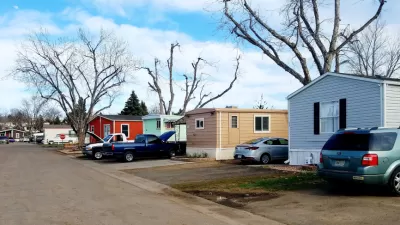Angela Kaufman purchased what she thought would be her longtime home in a mobile home community. Less than a year after she moved, the park was sold and residents were told they had to go.

The sun glitters on the blue waters of Saratoga Lake in upstate New York and refracts off the lines of bright white boats docked at a nearby boat launch and marina. The lake is located near Saratoga Springs, a longtime tourist destination in eastern Saratoga County that’s filled with all the hallmarks of a high-end vacation paradise—5-star hotels, a casino, golf course, racetrack, multiple entertainment venues, and the expensive and exclusive Prime Steak House. But luxury and scenery don’t convey a complete picture of the area.
Income inequality is stark in Saratoga County, so stark in fact that studies have put it on par with San Francisco and Manhattan. The Economic Policy Institute ranked the county 28th in income inequality out of 3,000 U.S. counties.
With such a difference in household incomes, and the rising cost of housing in the area, it isn’t surprising that Saratoga County is also home to the most mobile home parks in the entire state.
The Saratoga Lakeview Mobile Home Park, which lies adjacent to Saratoga Lake, is one such community. It’s where Angela Kaufman moved a few years ago in hopes of finding an affordable home for the long term. But things haven’t worked out as planned. The property changed ownership not too long after Kaufman moved in, and ever since, she says she’s been fighting to keep her home in the face of escalating harassment.
Kaufman’s story highlights a loophole in provisions that are supposed to protect mobile home park residents, as well as the power of park owners to make life difficult for tenants in technically legal ways.
‘We Thought We Were Doing the Right Thing’
Kaufman moved into Saratoga Lakeview Mobile Home Park in 2020 with her partner and two rescue dogs. It was there that she hoped to find some peace to recover from a brain injury and ride out the pandemic.
“My partner was not working at the time,” she recalls. “I am self-employed, my health was starting to deteriorate.” Their rent of $1,030 a month in the neighboring town of Clifton Park was going up regularly, and wealthy people were moving into the area from New York City. Knowing they were going to be priced out before long, they started looking at mobile homes.
Manufactured homes are one of the most common forms of unsubsidized affordable housing, especially in less urban areas. In a mobile home park, purchasers buy the physical homes, but pay lot rent to the owner of the land on which the home sits. Park owners are responsible for infrastructure and maintenance of common areas.
Kaufman and her partner looked at parks for a few months and even held off on making an offer on a home in another park because Kaufman’s partner had had a good experience with the then-owner of Lakeview, who had a reputation for being reasonable and hands-off with tenants. Lakeview was home to 14 households, including families with young kids, elderly folks with chronic diseases, and a few single young adults. When the couple visited the 3.2-acre park, there were obvious signs of disrepair—a decrepit pump house, potholes, and an abandoned trailer—and there were several Trump signs, which made them nervous.
FULL STORY: This Manufactured Home Park Will Soon Be Boat Storage, But One Resident Stays to Fight

Study: Maui’s Plan to Convert Vacation Rentals to Long-Term Housing Could Cause Nearly $1 Billion Economic Loss
The plan would reduce visitor accommodation by 25,% resulting in 1,900 jobs lost.

North Texas Transit Leaders Tout Benefits of TOD for Growing Region
At a summit focused on transit-oriented development, policymakers discussed how North Texas’ expanded light rail system can serve as a tool for economic growth.

Using Old Oil and Gas Wells for Green Energy Storage
Penn State researchers have found that repurposing abandoned oil and gas wells for geothermal-assisted compressed-air energy storage can boost efficiency, reduce environmental risks, and support clean energy and job transitions.

Santa Barbara Could Build Housing on County Land
County supervisors moved forward a proposal to build workforce housing on two county-owned parcels.

San Mateo Formally Opposes Freeway Project
The city council will send a letter to Caltrans urging the agency to reconsider a plan to expand the 101 through the city of San Mateo.

A Bronx Community Fights to Have its Voice Heard
After organizing and giving input for decades, the community around the Kingsbridge Armory might actually see it redeveloped — and they want to continue to have a say in how it goes.
Urban Design for Planners 1: Software Tools
This six-course series explores essential urban design concepts using open source software and equips planners with the tools they need to participate fully in the urban design process.
Planning for Universal Design
Learn the tools for implementing Universal Design in planning regulations.
Ascent Environmental
Borough of Carlisle
Institute for Housing and Urban Development Studies (IHS)
City of Grandview
Harvard GSD Executive Education
Toledo-Lucas County Plan Commissions
Salt Lake City
NYU Wagner Graduate School of Public Service





























